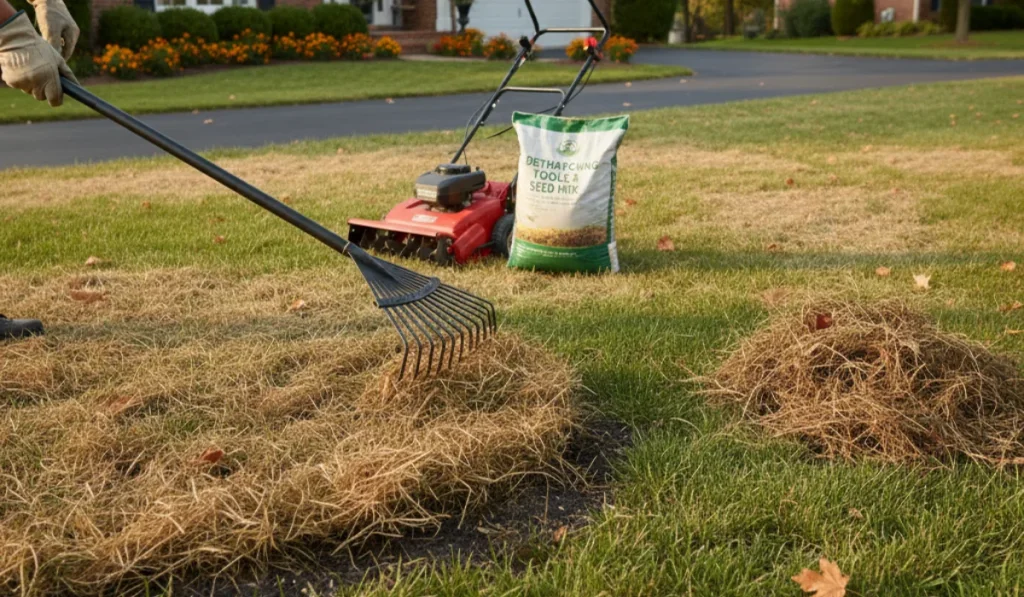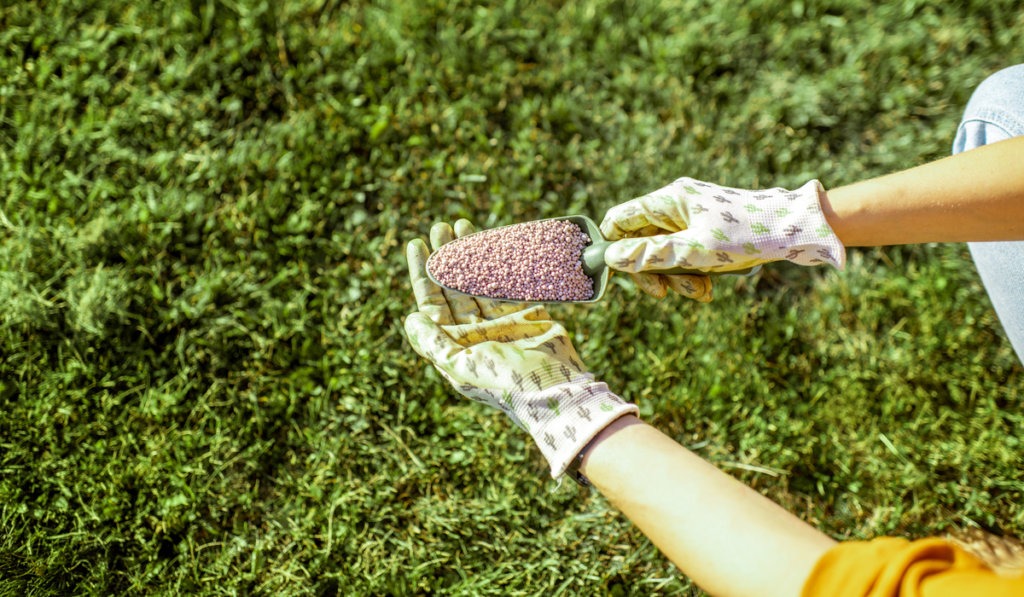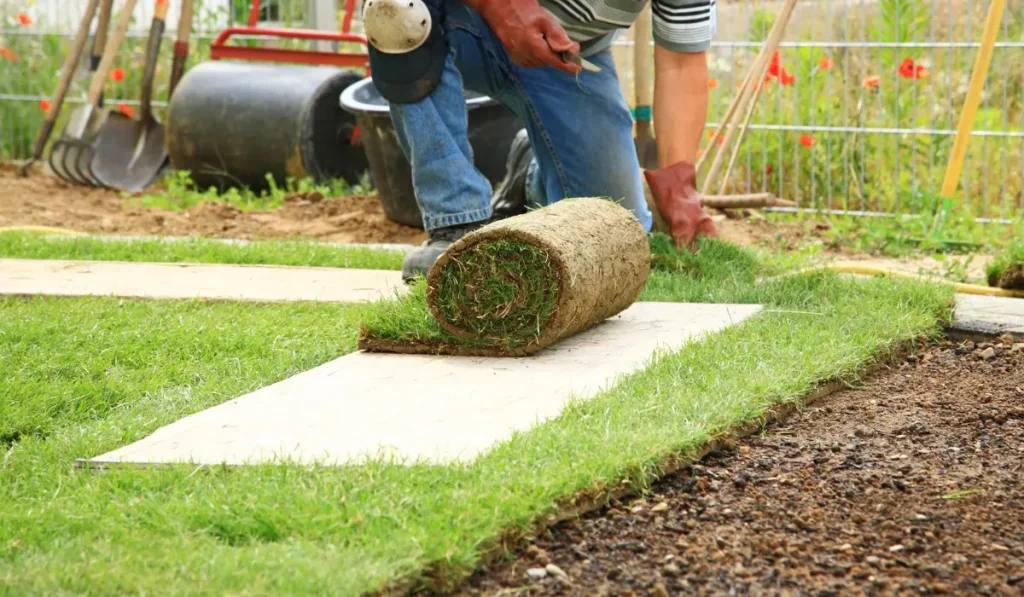Maintaining a lawn in California can be a challenging task. Hot summers, little rain, and strict watering rules make many homeowners ask: Is it drought stress or lawn fungus? Both can cause brown grass, discoloration, and wilting, but the solutions are very different.
If your lawn shows brown patches or uneven yellowing, you need to figure out what’s really going on. Applying a fungicide won’t help if your soil is simply dry, and watering more won’t fix a fungal disease like dollar spot or leaf spot. Learning the differences enables you to protect your turfgrass, save water, and keep a healthy lawn year-round.
From Sacramento to San Diego, lawns face the same challenges: heat, limited water, and occasional fungal outbreaks.
This guide shows how to distinguish between lawn fungus and drought stress, lists common California lawn diseases, and explains how dry weather affects grass. You’ll also learn where signs overlap, how to prevent problems, and how to choose the right fix for your yard.
Key takeaways
- Lawn fungus exhibits distinct patterns, such as circular brown patches, lesions, and sometimes visible spores on the grass.
- Drought stress appears more uniform, affecting larger areas where soil moisture is lacking or sprinkler coverage is uneven.
- Fungal diseases thrive in moisture, while drought stress worsens under California’s heat and limited watering restrictions.
- Correct diagnosis saves time and money, as treating drought stress with fungicide or watering a fungal lawn only exacerbates the problem.
Signs of lawn fungus vs drought stress
The first step in lawn care is determining whether your issue is a fungal disease or simply heat stress due to dry conditions.
Lawn fungus often appears as irregular, brown spots or circles with lesions on the blades. Common issues: brown patch, dollar spot, red thread, and leaf spot. Early mornings may reveal white or gray mycelium or tiny spore clusters on damp blades of grass. Sunlight dries them fast, so check early.
Drought stress usually shows uniform browning across larger areas. The soil feels dry, footprints linger, and the grass looks dull or bluish. Patterns often match poor sprinkler coverage, shallow roots, or compacted soil.
You can do a quick test by inserting a screwdriver into the ground. If it goes in easily and the soil feels damp, the problem is likely a lawn disease. If it’s hard to push in, soil moisture is low, and the grass needs proper watering.
Common lawn diseases in California
Warm, sunny days combined with cool evenings create an ideal environment for fungal diseases in turfgrass. Knowing the most common lawn diseases helps you narrow down what’s harming your yard.
- Brown patch hits fescue in warm, humid weather. Look for circular dead patches and dark-edged lesions on blades. Lesions and spores can spread the disease.
- Dollar spot makes small, straw-colored spots on Bermuda and zoysia. Without treatment, spots merge into larger brown areas, especially if the lawn stays wet.
- Red thread appears as pink or red threads on cool-season grasses, such as fescue. It thrives in low-nutrient soil and mild coastal areas.
- Leaf spot begins as small, dark dots that expand into larger, discolored areas. Over time, the turf thins, leaving dead patches.
Each of these diseases spreads through spores, which travel by wind, water, or even your mower. If you see recurring patches, cleaning your equipment and applying a preventive fungicide may help break the cycle.
How drought stress affects your lawn
When California heat spikes and water restrictions are in place, many lawns experience drought stress. Unlike fungal disease, which leaves patchy areas, drought stress causes widespread wilting, yellowing, and discoloration of the entire plant.
Lawns with shallow root growth or compacted soil dry out faster. High-traffic areas, such as kids’ play zones or dog paths, often show stress first. Cool-season grasses, such as fescue, lose color faster than warm-season grasses like Bermuda, zoysia, and St. Augustine, which are more drought-tolerant.
A drought-stressed lawn may also exhibit uneven, brown spots due to inadequate sprinkler coverage. If you notice the same dry patches repeating, it’s worth checking your irrigation system for clogs, leaks, or misaligned heads.
Fortunately, drought stress is reversible. Lawns typically recover when given proper watering, deep, infrequent soaking rather than shallow daily watering. Adding mulch around borders and improving aeration also helps your soil retain moisture.
Overlapping signs that confuse homeowners
The tricky part is that heat stress, lawn fungus, and drought stress often overlap, making diagnosis more challenging. For example:
- A lawn with brown patches could be dealing with fungus or just hot spots where the sprinkler doesn’t reach.
- Wilting and yellowing can be signs of drought stress, but they can also appear when fungus weakens the turfgrass.
- Dead grass after hot weather may not mean your lawn is dead; it may just be dormant due to heat stress.
That’s why it’s essential to look beyond surface signs. Check your soil moisture, inspect the leaf blades for lesions or spores, and consider the season. Fungus tends to strike when nights are cool and mornings are wet, while drought stress dominates during prolonged dry spells.
Best practices to prevent lawn stress
Whether you’re fighting lawn fungus or drought stress, prevention is always easier than repair.
Good lawn care includes balanced watering, seasonal aeration, and correct mowing height. Avoid cutting more than one-third of the leaf blades at a time, and keep your mower blades sharp to prevent tearing. A healthy lawn with vigorous root growth is more resistant to fungal disease, insect infestation, and heat stress.
For lawns prone to fungus, schedule seasonal fungicide treatments, especially if you’ve had brown patch or dollar spot before. Removing excess thatch and avoiding overwatering also reduces fungal outbreaks.
For drought-prone lawns, consider reseeding or overseeding with drought-tolerant grasses, such as Bermuda or zoysia. Using mulch around the edges, improving soil with organic matter, and practicing routine aeration also help retain moisture.
If insects such as chinch bugs or grubs contribute to the stress, you may need to apply targeted insect control. Alternatively, grub control treatments may be necessary. Pests often compound existing problems by thinning turf and making it more vulnerable to both drought and disease.
Seasonal lawn care in California
Because California’s climate ranges from cool coastal zones to hot inland valleys, timing matters in lawn care.
- In spring, cool mornings with heavy dew favor fungal growth. Watch for leaf spot, red thread, and dollar spot, especially in fescue lawns.
- In summer, long hot stretches cause drought stress and heat stress, especially in cool-season grasses. Adjust sprinkler schedules to provide deeper watering.
- In the fall, conditions often trigger brown patch, particularly on warm-season grasses like Bermuda as they begin to slow growth.
- In winter, most lawns go partially dormant, but overwatering during the rainier months can encourage fungus growth.
Following the seasonal cycle helps you anticipate problems and tailor care to your grass type.
Making the right lawn care choice for your California yard
When your lawn turns brown, don’t guess. Distinguishing between lawn fungus vs drought stress ensures you take the right action, whether that’s adjusting your sprinkler schedule, treating for fungal disease, or overseeding with cool-season grasses for winter color.
California homeowners face unique challenges, but with the right lawn care strategies, you can maintain a strong, green lawn through hot summers and mild winters.
If you’re ready to refresh your yard with sod that fits your lawn’s needs, SodLawn is here to help with high-quality drought-tolerant turfgrass and expert guidance. Contact us today and give your lawn the foundation it needs to stay healthy all year.
FAQs
How can I determine if brown spots are caused by fungus or drought stress?
Brown spots from fungus typically have distinct edges and may include lesions or clusters of spores on the grass blades, whereas soil moisture levels, which affect drought stress, appear more uniform.
What grass types in California resist drought stress best?
Bermuda, zoysia, and St. Augustine are warm-season grasses that excel in hot weather. For cooler regions, fescue and other cool-season grasses are suitable options; however, they require more water during the summer.
Should I water more if I think my lawn has fungus?
No. Extra water can exacerbate lawn diseases. Check your soil first. If it’s damp, treat it with a fungicide instead of watering. If it’s dry, adjust your watering habits. To the proper level



